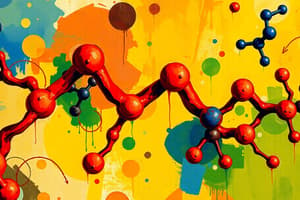Podcast
Questions and Answers
How is lactose classified?
How is lactose classified?
as a disaccharide
The bonding of two amino acid molecules to form a larger molecule requires?
The bonding of two amino acid molecules to form a larger molecule requires?
removal of a water molecule
The element nitrogen is found in all of the following except?
The element nitrogen is found in all of the following except?
- nucleotides
- monosaccharides (correct)
- proteins
- amino acids
Of the following functions, the major purpose of RNA is to?
Of the following functions, the major purpose of RNA is to?
What is a triglyceride?
What is a triglyceride?
A compound with the molecular formula C8H16O8 is most likely what type of macromolecule?
A compound with the molecular formula C8H16O8 is most likely what type of macromolecule?
Which bonds are created during the formation of the primary structure of a protein?
Which bonds are created during the formation of the primary structure of a protein?
Which maintains the secondary structure of a protein?
Which maintains the secondary structure of a protein?
Which of the following are pyrimidines?
Which of the following are pyrimidines?
Which best summarizes the difference between DNA and RNA?
Which best summarizes the difference between DNA and RNA?
An organic compound must contain at least one atom of?
An organic compound must contain at least one atom of?
Which of the following statements is true regarding isomers?
Which of the following statements is true regarding isomers?
Energy is stored in what part of ATP?
Energy is stored in what part of ATP?
Simple hydrocarbon chains are generally hydrophobic because they lack?
Simple hydrocarbon chains are generally hydrophobic because they lack?
Saturated fatty acids?
Saturated fatty acids?
Which of the following functional groups are found on amino acids?
Which of the following functional groups are found on amino acids?
Amino acids can be classified as?
Amino acids can be classified as?
An enzyme?
An enzyme?
A hexose sugar contains?
A hexose sugar contains?
Flashcards are hidden until you start studying
Study Notes
Carbohydrates
- Lactose is classified as a disaccharide, consisting of glucose and galactose linked by a glycosidic bond.
- A compound with the formula C8H16O8 indicates the presence of a carbohydrate.
- Hexose sugars, a category of carbohydrates, contain six carbon atoms.
Proteins
- The formation of proteins begins with peptide bonds, which connect amino acid molecules.
- Hydrogen bonds are crucial for maintaining the secondary structure of proteins.
- Amino acids have two functional groups: amino and carboxyl, and can be classified as polar or non-polar.
Lipids
- Triglycerides are lipids composed of three fatty acids and glycerol.
- Saturated fatty acids do not have double bonds between their carbon atoms.
Nucleic Acids
- RNA primarily functions in the synthesis of proteins.
- Pyrimidines, which are a category of nucleotides, include cytosine and uracil.
- DNA and RNA differ in that DNA nucleotides have a different sugar compared to RNA nucleotides.
Isomers
- Isomers are compounds with the same types and number of atoms and the same molecular weight, but different structures.
Organic Compounds
- An organic compound must contain at least one carbon atom.
- Hydrocarbon chains are hydrophobic due to the absence of polar or charged atoms.
Enzymes and Energy
- Enzymes are biological catalysts that speed up chemical reactions.
- Energy storage in ATP occurs at the third phosphate-phosphate bond, a key aspect of cellular energy transfer.
Functional Groups
- The presence of a carboxyl group in a hydrocarbon prevents it from dissolving in water, highlighting the importance of functional groups in solubility.
Studying That Suits You
Use AI to generate personalized quizzes and flashcards to suit your learning preferences.




